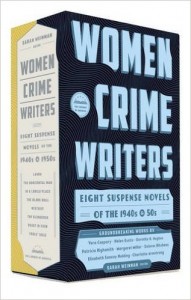 I reviewed Women Crime Writers: Eight Suspense Novels of the 1940s and 1950s, edited by Sarah Weinman, in Saturday’s Wall Street Journal. Here’s an excerpt.
I reviewed Women Crime Writers: Eight Suspense Novels of the 1940s and 1950s, edited by Sarah Weinman, in Saturday’s Wall Street Journal. Here’s an excerpt.
* * *
The Library of America, which specialized once upon a time in reprinting what its dust jackets continue to describe as “America’s best and most significant writing,” has long since succumbed to mission creep. These days it’s as likely to publish Kurt Vonnegut as Edith Wharton, and a fast-growing chunk of its catalog consists of mystery novels and other crime fiction by writers both familiar (Dashiell Hammett) and obscure ( David Goodis). Now comes “Women Crime Writers,” a two-volume anthology edited by Sarah Weinman, a respected critic of the sanguinary genre, that contains eight novels by seven obscure authors and a ringer, Patricia Highsmith, who is still widely remembered for having written “Strangers on a Train” and created Tom Ripley, the sociopath you love to hate,
So are these novels good, significant, neither, or both?
The fact that they were written by women is of no great consequence in and of itself. Women have been writing successful crime novels since the 19th century. Indeed, most of the books in “Women Crime Writers” were popular when they first came out, and Vera Caspary’s “Laura” (1943), Dorothy B. Hughes’s “In a Lonely Place” (1947), Elisabeth Sanxay Holding’s “The Blank Wall” (1947, filmed as “The Reckless Moment”), and Charlotte Armstrong’s “Mischief” (1950, filmed as “Don’t Bother to Knock”) were later turned into movies that starred such A-list actors as Humphrey Bogart, James Mason, Marilyn Monroe and Gene Tierney. Yet none of them, not even Highsmith’s “The Blunderer” (1954), managed to make posterity’s cut. What, then, makes them worthy of revival now?
The answer is that they are all exceptionally fine, as much so as any of the crime novels written by men that were published in this country in the 1940s and 1950s. In particular, I wouldn’t hesitate to stack “The Blunderer,” “In a Lonely Place” and Margaret Millar’s “Beast in View” (1955) up against the best work of Raymond Chandler and Ross Macdonald (who was Millar’s husband), both of whom have already been declared significant by the Library of America.
But the other books in “Women Crime Writers,” very much including Helen Eustis’s “The Horizontal Man” (1946) and Dolores Hitchens’s “Fool’s Gold” (1958), are closely comparable in quality to their companions: Each of them is smartly plotted, tautly written, sharply characterized and not at all dated….
* * *
Read the whole thing here.
The opening sequence of The Reckless Moment, Max Ophüls’ 1949 film version of Elisabeth Sanxay Holding’s The Blank Wall, starring Joan Bennett and James Mason:


